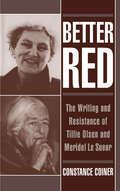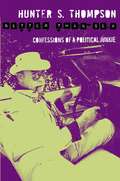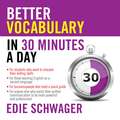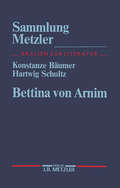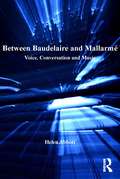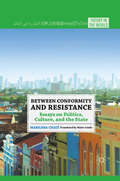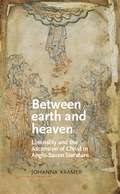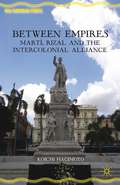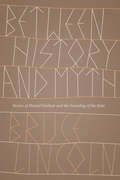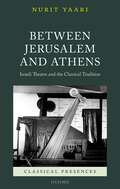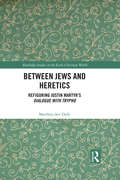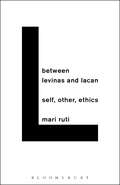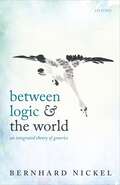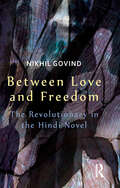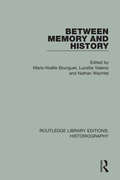- Table View
- List View
Better Red: The Writing and Resistance of Tillie Olsen and Meridel Le Sueur
by Constance CoinerBetter Red is an interdisciplinary study addressing the complicated intersection of American feminism and the political left as refracted in Tillie Olsen's and Meridel Le Sueur's lives and literary texts. The first book-length study to explore these feminist writers' ties to the American Communist Party, it contributes to a reenvisioning of 1930s U.S. Communism as well as to efforts to promote working-class writing as a legitimate category of literary analysis. At once loyal members of the male-dominated Communist party and emerging feminists, Olsen and Le Sueur exhibit in their writing tendencies both toward and away from Party tenets and attitudes--at points subverting formalist as well as orthodox Marxist literary categories. By producing working-class discourse, Olsen and Le Sueur challenge the bourgeois assumptions--often masked as classless and universal--of much canonical literature; and by creating working-class women's writing, they problematize the patriarchal nature of the Left and the masculinist assumptions of much proletarian literature, anticipating the concerns of "second wave" feminists a generation later.
Better Than Sex (Gonzo Papers #Vol. 4)
by Hunter Thompson‘Hunter S. Thompson is to drug-addled, stream-of-consciousness, psycho-political black humor what Forrest Gump is to idiot savants’ Philadelphia Inquirer Since his blazing 1972 opus, Fear and Loathing on the Campaign Trail, Hunter S. Thompson has reported the election story in his truly inimitable, just-short-of-libel style. In Better than Sex, Thompson hits the dusty trail again – without leaving home – yet manages to deliver a mind-bending view of the 1992 presidential campaign, in all of its horror, sacrifice, lust, and dubious glory. Complete with faxes sent to and received by candidate Clinton’s top aides, and 100 per cent pure gonzo screeds on Richard Nixon, George Bush, and Oliver North, here is the most true-blue campaign tell-all ever penned by man or beast. ‘[Thompson] delivers yet another of his trademark cocktail mixes of unbelievable tales and dark observations . . . Packed with egocentric anecdotes, musings and reprints of memos, faxes and scrawled handwritten notes’ Los Angeles Daily News
Better Vocabulary in 30 Minutes a Day (PDF)
by Edie Schwager Sean PrattPlease note: This PDF is not e-reader compatible but can be zoomed in and out. Would you like to find new, exciting words to use in your speech and writing? Would you like to be a fascinating conversationalist? Would you like to be a Scrabble expert? Better Vocabulary In 30 Minutes a Day offers a lively and entertaining method for adding a more impressive list of words to your everyday speech, and for learning how to use them effortlessly and accurately. Besides giving definitions, this invaluable guide also provides root meanings and elements of words so you can increase your vocabulary base by thousands of exciting new words and use them with aplomb in sentences. Sprinkled throughout the book are fascinating stories about words and their origins. Even if you can't spare 30 minutes a day to learn to speak and write eloquently, Better Vocabulary In 30 Minutes a Day allows you to customize your learning to take as little as five minutes a day. That's a small commitment for the lifelong benefit of speaking and writing better! Like its companion guides in the Better English Series, this book is just what you need for confident, clear writing and speaking!
Bettina von Arnim (Sammlung Metzler)
by Konstanze Bäumer Hartwig SchultzBettina von Arnim, die engagierte sozialkritische Autorin und Salonière des Vormärz, wurde von Christa Wolf in den sechziger Jahren wiederentdeckt. Seitdem hat sich ihr auch die Literaturwissenschaft zugewandt.
Between Baudelaire and Mallarmé: Voice, Conversation and Music
by Helen AbbottAs the status of poetry became less and less certain over the course of the nineteenth century, poets such as Baudelaire and Mallarmé began to explore ways to ensure that poetry would not be overtaken by music in the hierarchy of the arts. Helen Abbott examines the verse and prose poetry of these two important poets, together with their critical writings, to address how their attitudes towards the performance practice of poetry influenced the future of both poetry and music. Central to her analysis is the issue of 'voice', a term that remains elusive in spite of its broad application. Acknowledging that voice can be physical, textual and symbolic, Abbott explores the meaning of voice in terms of four categories: (1) rhetoric, specifically the rules governing the deployment of voice in poetry; (2) the human body and its effect on how voice is used in poetry; (3) exchange, that is, the way voices either interact or fail to interact; and (4) music, specifically the question of whether poetry should be sung. Abbott shows how Baudelaire and Mallarmé exploit the complexity and instability of the notion of voice to propose a new aesthetic that situates poetry between conversation and music. Voice thus becomes an important process of interaction and exchange rather than something stable or static; the implications of this for Baudelaire and Mallarmé are profoundly significant, since it maps out the possible future of poetry.
Between Baudelaire and Mallarmé: Voice, Conversation and Music
by Helen AbbottAs the status of poetry became less and less certain over the course of the nineteenth century, poets such as Baudelaire and Mallarmé began to explore ways to ensure that poetry would not be overtaken by music in the hierarchy of the arts. Helen Abbott examines the verse and prose poetry of these two important poets, together with their critical writings, to address how their attitudes towards the performance practice of poetry influenced the future of both poetry and music. Central to her analysis is the issue of 'voice', a term that remains elusive in spite of its broad application. Acknowledging that voice can be physical, textual and symbolic, Abbott explores the meaning of voice in terms of four categories: (1) rhetoric, specifically the rules governing the deployment of voice in poetry; (2) the human body and its effect on how voice is used in poetry; (3) exchange, that is, the way voices either interact or fail to interact; and (4) music, specifically the question of whether poetry should be sung. Abbott shows how Baudelaire and Mallarmé exploit the complexity and instability of the notion of voice to propose a new aesthetic that situates poetry between conversation and music. Voice thus becomes an important process of interaction and exchange rather than something stable or static; the implications of this for Baudelaire and Mallarmé are profoundly significant, since it maps out the possible future of poetry.
Between Conformity and Resistance: Essays on Politics, Culture, and the State (Theory in the World)
by M. ChauíSince the 1980's, Marilena Chauí's writing has had a profound impact in Brazil, contributing to the academic conversation and resonating in popular culture. Here, in English for the first time, are ten of Chauí's most important essays, with an introduction by Maite Conde which situates the scholarship in the global context.
Between earth and heaven: Liminality and the Ascension of Christ in Anglo-Saxon literature (PDF) (Manchester Medieval Literature and Culture)
by Johanna KramerBetween earth and heaven examines the teaching of the theology of Christ’s ascension in Anglo-Saxon literature, offering the only comprehensive examination of how patristic ascension theology is transmitted, adapted and taught to Anglo-Saxon audiences. This book argues that Anglo-Saxon authors recognise the Ascension as fundamentally liminal in nature, as concerned with crossing boundaries and inhabiting dual states. In their teaching, authors convert abstract theology into concrete motifs reflecting this liminality, such as the gates of heaven and Christ’s footprints. By examining a range of liminal imagery, Between earth and heaven demonstrates the consistent sophistication and unity of Ascension theology in such diverse sources as Latin and Old English homilies, religious poetry, liturgical practices, and lay popular beliefs and rituals. This study not only refines our evaluation of Anglo-Saxon authors’ knowledge of patristic theology and their process of source adaptation, but also offers a new understanding of the methods of religious instruction and uses of religious texts in Anglo-Saxon England, capturing their lived significance to contemporary audiences.
Between earth and heaven: Liminality and the Ascension of Christ in Anglo-Saxon literature (Manchester Medieval Literature and Culture)
by Johanna KramerBetween earth and heaven examines the teaching of the theology of Christ’s ascension in Anglo-Saxon literature, offering the only comprehensive examination of how patristic ascension theology is transmitted, adapted and taught to Anglo-Saxon audiences. This book argues that Anglo-Saxon authors recognise the Ascension as fundamentally liminal in nature, as concerned with crossing boundaries and inhabiting dual states. In their teaching, authors convert abstract theology into concrete motifs reflecting this liminality, such as the gates of heaven and Christ’s footprints. By examining a range of liminal imagery, Between earth and heaven demonstrates the consistent sophistication and unity of Ascension theology in such diverse sources as Latin and Old English homilies, religious poetry, liturgical practices, and lay popular beliefs and rituals. This study not only refines our evaluation of Anglo-Saxon authors’ knowledge of patristic theology and their process of source adaptation, but also offers a new understanding of the methods of religious instruction and uses of religious texts in Anglo-Saxon England, capturing their lived significance to contemporary audiences.
Between Empires: Martí, Rizal, and the Intercolonial Alliance (New Caribbean Studies)
by Koichi HagimotoIn 1898, both Cuba and the Philippines achieved their independence from Spain and then immediately became targets of US expansionism. This book presents a comparative analysis of late-nineteenth-century literature and history in Cuba and the Philippines, focusing on the writings of José Martí and José Rizal to reveal shared anti-imperial struggles.
Between History and Myth: Stories of Harald Fairhair and the Founding of the State
by Bruce LincolnAll groups tell stories about their beginnings. Such tales are oft-repeated, finely wrought, and usually much beloved. Among those institutions most in need of an impressive creation account is the state: it’s one of the primary ways states attempt to legitimate themselves. But such founding narratives invite revisionist retellings that modify details of the story in ways that undercut, ironize, and even ridicule the state’s ideal self-representation. Medieval accounts of how Norway was unified by its first king provide a lively, revealing, and wonderfully entertaining example of this process. Taking the story of how Harald Fairhair unified Norway in the ninth century as its central example, Bruce Lincoln illuminates the way a state’s foundation story blurs the distinction between history and myth and how variant tellings of origin stories provide opportunities for dissidence and subversion as subtle—or not so subtle—modifications are introduced through details of character, incident, and plot structure. Lincoln reveals a pattern whereby texts written in Iceland were more critical and infinitely more subtle than those produced in Norway, reflecting the fact that the former had a dual audience: not just the Norwegian court, but also Icelanders of the twelfth and thirteenth centuries, whose ancestors had fled from Harald and founded the only non-monarchic, indeed anti-monarchic, state in medieval Europe. Between History and Myth will appeal not only to specialists in Scandinavian literature and history but also to anyone interested in memory and narrative.
Between History and Myth: Stories of Harald Fairhair and the Founding of the State
by Bruce LincolnAll groups tell stories about their beginnings. Such tales are oft-repeated, finely wrought, and usually much beloved. Among those institutions most in need of an impressive creation account is the state: it’s one of the primary ways states attempt to legitimate themselves. But such founding narratives invite revisionist retellings that modify details of the story in ways that undercut, ironize, and even ridicule the state’s ideal self-representation. Medieval accounts of how Norway was unified by its first king provide a lively, revealing, and wonderfully entertaining example of this process. Taking the story of how Harald Fairhair unified Norway in the ninth century as its central example, Bruce Lincoln illuminates the way a state’s foundation story blurs the distinction between history and myth and how variant tellings of origin stories provide opportunities for dissidence and subversion as subtle—or not so subtle—modifications are introduced through details of character, incident, and plot structure. Lincoln reveals a pattern whereby texts written in Iceland were more critical and infinitely more subtle than those produced in Norway, reflecting the fact that the former had a dual audience: not just the Norwegian court, but also Icelanders of the twelfth and thirteenth centuries, whose ancestors had fled from Harald and founded the only non-monarchic, indeed anti-monarchic, state in medieval Europe. Between History and Myth will appeal not only to specialists in Scandinavian literature and history but also to anyone interested in memory and narrative.
Between History and Myth: Stories of Harald Fairhair and the Founding of the State
by Bruce LincolnAll groups tell stories about their beginnings. Such tales are oft-repeated, finely wrought, and usually much beloved. Among those institutions most in need of an impressive creation account is the state: it’s one of the primary ways states attempt to legitimate themselves. But such founding narratives invite revisionist retellings that modify details of the story in ways that undercut, ironize, and even ridicule the state’s ideal self-representation. Medieval accounts of how Norway was unified by its first king provide a lively, revealing, and wonderfully entertaining example of this process. Taking the story of how Harald Fairhair unified Norway in the ninth century as its central example, Bruce Lincoln illuminates the way a state’s foundation story blurs the distinction between history and myth and how variant tellings of origin stories provide opportunities for dissidence and subversion as subtle—or not so subtle—modifications are introduced through details of character, incident, and plot structure. Lincoln reveals a pattern whereby texts written in Iceland were more critical and infinitely more subtle than those produced in Norway, reflecting the fact that the former had a dual audience: not just the Norwegian court, but also Icelanders of the twelfth and thirteenth centuries, whose ancestors had fled from Harald and founded the only non-monarchic, indeed anti-monarchic, state in medieval Europe. Between History and Myth will appeal not only to specialists in Scandinavian literature and history but also to anyone interested in memory and narrative.
Between History and Myth: Stories of Harald Fairhair and the Founding of the State
by Bruce LincolnAll groups tell stories about their beginnings. Such tales are oft-repeated, finely wrought, and usually much beloved. Among those institutions most in need of an impressive creation account is the state: it’s one of the primary ways states attempt to legitimate themselves. But such founding narratives invite revisionist retellings that modify details of the story in ways that undercut, ironize, and even ridicule the state’s ideal self-representation. Medieval accounts of how Norway was unified by its first king provide a lively, revealing, and wonderfully entertaining example of this process. Taking the story of how Harald Fairhair unified Norway in the ninth century as its central example, Bruce Lincoln illuminates the way a state’s foundation story blurs the distinction between history and myth and how variant tellings of origin stories provide opportunities for dissidence and subversion as subtle—or not so subtle—modifications are introduced through details of character, incident, and plot structure. Lincoln reveals a pattern whereby texts written in Iceland were more critical and infinitely more subtle than those produced in Norway, reflecting the fact that the former had a dual audience: not just the Norwegian court, but also Icelanders of the twelfth and thirteenth centuries, whose ancestors had fled from Harald and founded the only non-monarchic, indeed anti-monarchic, state in medieval Europe. Between History and Myth will appeal not only to specialists in Scandinavian literature and history but also to anyone interested in memory and narrative.
Between Jerusalem and Athens: Israeli Theatre and the Classical Tradition (Classical Presences)
by Nurit YaariHow does a theatrical tradition emerge in the fields of dramatic writing and artistic performance? How can a culture in which theatre played no part in the past create a theatrical tradition in the modern world? How do political and social conditions affect the encounter between cultures, and what role do they play in creating a theatre with a distinctive identity? This volume attempts to answer these and other questions in the first in-depth study of the reception of ancient Greek drama in Israeli theatre over the last 70 years. Exploring how engagement with classical culture has shaped the evolution of Israel's theatrical identity, it draws on both dramatic and aesthetic issues - from mise en scène to 'post dramatic' performance - and offers ground-breaking analysis of a wide range of translations and adaptations of Greek drama, as well as new writing inspired by Greek antiquity. The detailed discussion of how the performances of these works were created and staged at key points in the development of Israeli culture not only sheds new light on the reception of ancient Greek drama in an important theatrical and cultural context, but also offers a new and illuminating perspective on artistic responses to the fateful political, social, and cultural events in Israel's recent history.
Between Jerusalem and Athens: Israeli Theatre and the Classical Tradition (Classical Presences)
by Nurit YaariHow does a theatrical tradition emerge in the fields of dramatic writing and artistic performance? How can a culture in which theatre played no part in the past create a theatrical tradition in the modern world? How do political and social conditions affect the encounter between cultures, and what role do they play in creating a theatre with a distinctive identity? This volume attempts to answer these and other questions in the first in-depth study of the reception of ancient Greek drama in Israeli theatre over the last 70 years. Exploring how engagement with classical culture has shaped the evolution of Israel's theatrical identity, it draws on both dramatic and aesthetic issues - from mise en scène to 'post dramatic' performance - and offers ground-breaking analysis of a wide range of translations and adaptations of Greek drama, as well as new writing inspired by Greek antiquity. The detailed discussion of how the performances of these works were created and staged at key points in the development of Israeli culture not only sheds new light on the reception of ancient Greek drama in an important theatrical and cultural context, but also offers a new and illuminating perspective on artistic responses to the fateful political, social, and cultural events in Israel's recent history.
Between Jews and Heretics: Refiguring Justin Martyr’s Dialogue with Trypho (Routledge Studies in the Early Christian World)
by Matthijs den DulkJustin Martyr’s Dialogue with Trypho is the oldest preserved literary dialogue between a Jew and a Christian and a key text for understanding the development of early Judaism and Christianity. In Between Jews and Heretics, Matthijs den Dulk argues that whereas scholarship has routinely cast this important text in terms of "Christianity vs. Judaism," its rhetorical aims and discursive strategies are considerably more complex, because Justin is advocating his particular form of Christianity in constant negotiation with rival forms of Christianity. The striking new interpretation proposed in this study explains many of the Dialogue’s puzzling features and sheds new light on key passages. Because the Dialogue is a critical document for the early history of Jews and Christians, this book contributes to a range of important questions, including the emergence of the notion of heresy and the "parting of the ways" between Jews and Christians.
Between Jews and Heretics: Refiguring Justin Martyr’s Dialogue with Trypho (Routledge Studies in the Early Christian World)
by Matthijs den DulkJustin Martyr’s Dialogue with Trypho is the oldest preserved literary dialogue between a Jew and a Christian and a key text for understanding the development of early Judaism and Christianity. In Between Jews and Heretics, Matthijs den Dulk argues that whereas scholarship has routinely cast this important text in terms of "Christianity vs. Judaism," its rhetorical aims and discursive strategies are considerably more complex, because Justin is advocating his particular form of Christianity in constant negotiation with rival forms of Christianity. The striking new interpretation proposed in this study explains many of the Dialogue’s puzzling features and sheds new light on key passages. Because the Dialogue is a critical document for the early history of Jews and Christians, this book contributes to a range of important questions, including the emergence of the notion of heresy and the "parting of the ways" between Jews and Christians.
Between Levinas and Lacan: Self, Other, Ethics
by Mari RutiLevinas and Lacan, two giants of contemporary theory, represent schools of thought that seem poles apart. In this major new work, Mari Ruti charts the ethical terrain between them. At first glance, Levinansian and Lacanian approaches may seem more or less incompatible, and in many ways they are, particularly in their understanding of the self-other relationship. For both Levinas and Lacan, the subject's relationship to the other is primary in the sense that the subject, literally, does not exist without the other, but they see the challenge of ethics quite differently: while Levinas laments our failure to adequately meet the ethical demand arising from the other, Lacan laments the consequences of our failure to adequately escape the forms this demand frequently takes. Although this book outlines the major differences between Levinas and Judith Butler on the one hand and Lacan, Slavoj Žižek, and Alain Badiou on the other, Ruti proposes that underneath these differences one can discern a shared concern with the thorny relationship between the singularity of experience and the universality of ethics. Between Levinas and Lacan is an important new book for anyone interested in contemporary theory, ethics, psychoanalysis, and feminist and queer theory.
Between Levinas and Lacan: Self, Other, Ethics
by Mari RutiLevinas and Lacan, two giants of contemporary theory, represent schools of thought that seem poles apart. In this major new work, Mari Ruti charts the ethical terrain between them. At first glance, Levinansian and Lacanian approaches may seem more or less incompatible, and in many ways they are, particularly in their understanding of the self-other relationship. For both Levinas and Lacan, the subject's relationship to the other is primary in the sense that the subject, literally, does not exist without the other, but they see the challenge of ethics quite differently: while Levinas laments our failure to adequately meet the ethical demand arising from the other, Lacan laments the consequences of our failure to adequately escape the forms this demand frequently takes. Although this book outlines the major differences between Levinas and Judith Butler on the one hand and Lacan, Slavoj Žižek, and Alain Badiou on the other, Ruti proposes that underneath these differences one can discern a shared concern with the thorny relationship between the singularity of experience and the universality of ethics. Between Levinas and Lacan is an important new book for anyone interested in contemporary theory, ethics, psychoanalysis, and feminist and queer theory.
Between Logic and the World: An Integrated Theory of Generics
by Bernhard NickelBetween Logic and the World presents a theory of generic sentences and the kind-directed modes of thought they express. The theory closely integrates compositional semantics with metaphysics to solve the problem that generics pose: what do generics mean? Generic sentences are extremely simple, yet if there are patterns to be discerned in terms of which are true and which are false, these patterns are subtle and complex. Ravens are black, lions have manes, sea-turtles are long-lived, and bishops in chess move along diagonals. Statistical measures cannot do justice to the facts, but what else is there that at least has a hope of giving us insight into what we are capturing across so many domains? Bernhard Nickel argues that generics are the top of a fundamentally explanatory iceberg. By focusing on blackness in ravens and manes in lions, for instance, we can place the kinds into a framework structured by explanatory considerations. Between Logic and the World argues that this explanatory framework is deeply intertwined with the semantics of the language we use to express them, and in giving its integrated semantic and metaphysical theory of generics, it aims to solve old puzzles and draw attention to new phenomena.
Between Love and Freedom: The Revolutionary in the Hindi Novel
by Nikhil GovindBetween Love and Freedom interprets the figure of the revolutionary in the Hindi novel by establishing its lineage in representative Bengali novels, as well as in the contending moralities of Mahatma Gandhi and Bhagat Singh on the idea of violence. It reveals how conventional social realism and emergent modernist modes were brought together in the novelistic tradition by extending the political ideal of anti-colonial revolution into domains of sexual desire and subjective expression, especially in the works of Agyeya, Jainendra, and Yashpal. This work will deeply interest scholars and students of literature, modern Indian history, Hindi, and political science.
Between Love and Freedom: The Revolutionary in the Hindi Novel
by Nikhil GovindBetween Love and Freedom interprets the figure of the revolutionary in the Hindi novel by establishing its lineage in representative Bengali novels, as well as in the contending moralities of Mahatma Gandhi and Bhagat Singh on the idea of violence. It reveals how conventional social realism and emergent modernist modes were brought together in the novelistic tradition by extending the political ideal of anti-colonial revolution into domains of sexual desire and subjective expression, especially in the works of Agyeya, Jainendra, and Yashpal. This work will deeply interest scholars and students of literature, modern Indian history, Hindi, and political science.
Between Memory and History (Routledge Library Editions: Historiography #6)
by Marie-Noëlle Bourguet Lucette Valensi Nathan WachtelThe recent wave of interest in oral history and return to the active subject as a topic in historical practice raises a number of questions about the status and function of scholarly history in our societies. This articles in this volume, originally pubished in 1990, and which originally appeared in History and Anthropology, Volume 2, Part 2, discuss what contributions, meanings and consequences emerge from scholarly history turning to living memory, and what the relationships are between history and memory.
Between Memory and History (Routledge Library Editions: Historiography)
by Marie-Noëlle Bourguet Lucette Valensi Nathan WachtelThe recent wave of interest in oral history and return to the active subject as a topic in historical practice raises a number of questions about the status and function of scholarly history in our societies. This articles in this volume, originally pubished in 1990, and which originally appeared in History and Anthropology, Volume 2, Part 2, discuss what contributions, meanings and consequences emerge from scholarly history turning to living memory, and what the relationships are between history and memory.
